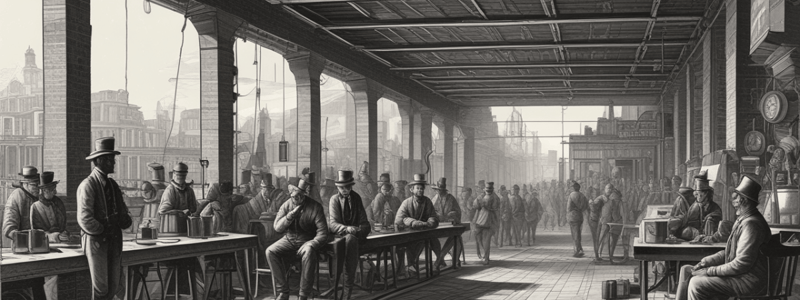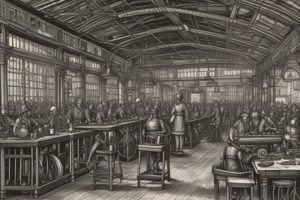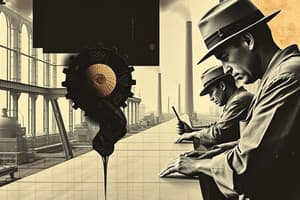Podcast
Questions and Answers
What was the primary consequence of the Industrial Revolution in America?
What was the primary consequence of the Industrial Revolution in America?
- The shift from agriculture to service-based economy
- The decrease in the value of industrial output
- The movement of production from home businesses to machines in factories (correct)
- The rise of skilled artisans in the South
What was the significance of Samuel Slater's textile factory in 1790?
What was the significance of Samuel Slater's textile factory in 1790?
- It marked the beginning of the Industrial Revolution in the South
- It led to the decline of agriculture in New England
- It was the first factory to use coal as an industrial power source
- It steered New England on a clear economic path (correct)
What innovation did Eli Whitney demonstrate in 1801?
What innovation did Eli Whitney demonstrate in 1801?
- The invention of the cotton gin
- The use of coal as an industrial power source
- The development of the steam engine
- Interchangeable parts (correct)
What was the result of the Industrial Revolution in the North by 1850?
What was the result of the Industrial Revolution in the North by 1850?
What was the primary reason for the South's dependence on labor of enslaved people?
What was the primary reason for the South's dependence on labor of enslaved people?
What was the characteristic of the women working in Francis Lowell's textile factory?
What was the characteristic of the women working in Francis Lowell's textile factory?
How many hours did factory women work per week?
How many hours did factory women work per week?
Why did thousands of young women earn their own living in the textile factory?
Why did thousands of young women earn their own living in the textile factory?
What was the result of rapid urbanization in America during the antebellum years?
What was the result of rapid urbanization in America during the antebellum years?
What percentage of Americans lived in a city by 1860?
What percentage of Americans lived in a city by 1860?
What percentage of the goods produced in America between the turn of the century and the start of the Civil War came from factories in the Northeast?
What percentage of the goods produced in America between the turn of the century and the start of the Civil War came from factories in the Northeast?
What invention led to a surge in American innovations and patents between 1830 and 1850?
What invention led to a surge in American innovations and patents between 1830 and 1850?
Who invented the mechanical reaper and the steel plow?
Who invented the mechanical reaper and the steel plow?
What was the result of the tariffs passed throughout the first half of the century?
What was the result of the tariffs passed throughout the first half of the century?
What was the primary advantage of corporations over business partnerships?
What was the primary advantage of corporations over business partnerships?
Flashcards are hidden until you start studying
Study Notes
Industrial Revolution in America
- The Industrial Revolution in America was a century-long process that moved production from skilled artisans to machines in factories.
- In 1790, Samuel Slater built America's first textile factory in Rhode Island, steering New England on a clear economic path.
Innovations and Inventions
- Eli Whitney demonstrated interchangeable parts in 1801, setting off half a century of innovations and inventions in American business and manufacturing.
- By 1850, the value of industrial output surpassed the value of agriculture, signaling a secondary commercial revolution.
- The North became dependent on a commercial economy, while the South became increasingly dependent on labor of enslaved people.
Regional Differences
- The colonial economies evolved differently due to geography, with the South conducive to cash crops and the North having fast-moving rivers that powered machinery.
- The South seemed to be regressing in terms of technology, while the North came to depend on a commercial economy for their livelihood.
Transportation Networks
- Growing transportation networks created a web across the Northeastern and Middle states, connecting the North to the West.
- The Erie Canal and railroad tracks encouraged even more commerce and population growth, leaving the South increasingly isolated from the rest of the nation.
19th-Century Inventors and Inventions
- The power-driven machinery of New England textile factories spread to many other industries, creating a surge in American inventions and innovations.
- The invention of the sewing machine mid-century meant that fabric produced in Northern factories could be sewn into clothing in Northern factories.
- Steam engines were adapted for all kinds of machinery, including ships and mills and printing presses.
- Cyrus McCormick's mechanical reaper and John Deere's steel plow benefited farmers.
- Charles Goodyear's process for vulcanizing rubber allowed for the development of the automobile industry.
- Samuel Morse invented the electric telegraph and Morse code in 1844, revolutionizing communication.
Effects and Consequences of Northern Commerce
- Factories and industrialization led to profound social, political, and demographic effects on the young nation.
- The government passed a series of protective tariffs to protect fledgling American industries, raising the cost of imported goods and making domestic goods more competitive.
- Tariffs were a disaster for Southern cotton-growers, causing economic controversy and nearly leading to a civil war in the 1830s.
- Industrialization changed business practices, with corporations becoming more common and allowing for the pooling of capital from many investors.
- The factory system transformed the workforce, with women earning their own living and gaining independence in America.
Demographics
- The population of towns and cities of 8,000 or more increased by 90%, with rapid urbanization causing its own set of problems.
- By 1860, about one in seven Americans lived in a city, setting the stage for America to become an urban nation and the world's leading industrial producer.
Studying That Suits You
Use AI to generate personalized quizzes and flashcards to suit your learning preferences.




